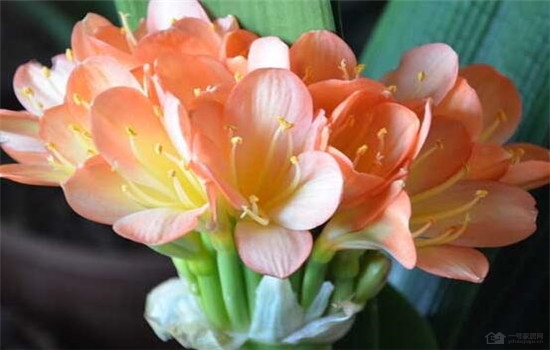How to raise the orchid in autumn is the key to the right method.
In autumn, many plants begin to lose their leaves and wither, and the methods of plant breeding will change in the new season. If there is a planting monarch orchid at home, you should pay attention to the corresponding breeding methods in the autumn. But how to raise a gentleman's orchid in autumn?

1. Water: as we all know, plants cannot grow without water, and their nutrients absorption and various physiological activities must depend on water, but different plants have different requirements for water, and the water quality varies from place to place. The requirements for water are as follows:
The pH of water: Cymbidium prefers neutral or slightly acidic water, with a PH value of about 6.5. The pH of water quality varies from place to place, and if it is not neutral or slightly acidic water, consideration should be given to improving it. If the alkaline water can be neutralized with rice panning water.
Water quality: the quality of tap water, river water and lake water is different from each other, and cleaning water rich in minerals is the best. Tap water after artificial chemical treatment, usually should be stored for a few days, and then used to water flowers.
Water content in the soil: the suitable water content should be 20%-40%, which is not dry or wet. If the water content in the soil is too high for a long time, the air permeability in the soil will become worse, which is easy to cause rotten roots; otherwise, if the water content is too low, it will dehydrate, resulting in root dryness and withering.
Watering method: the principle of watering is not dry but thoroughly watered. Scratching the surface a little at a time will do great harm. What we are talking about here is not dry until there is no water, but that the water content in the soil is low, that is, it is time to water. People who often raise orchids usually flick flowerpots with their fingers to judge the water content in the soil by the sound of bouncing. The sound of bouncing is dull, indicating that the water content in the soil is high and does not need to be watered; on the contrary, the clear sound means that the water content in the soil is low and should be watered immediately. The practice of scratching the surface is extremely harmful because most of the small amount of water is absorbed by the soil or flows directly down the pipes formed in the soil, and the roots absorb very little, which is almost equivalent to no watering.
In addition, watering should also pay attention to that the water temperature should be close to the soil temperature, and the temperature difference between them should not be too large; the watering time should be in the morning and evening, and at noon in summer, the temperature is very high, so it is not suitable for watering; watering should avoid the heart of flowers, especially during the flowering period of the arrows, which is caused by waterproof and unclean.
two。 Soil: the root of Cymbidium is fleshy, which is suitable for growing in loose, fertile, water-permeable and air-permeable soil, so these four factors should be strictly considered in the selection of cultivated soil.
Soil quality: humus soil meets the above four requirements and is the first choice for orchid cultivation. Humus soil had better be oak leaves (oak leaves), other leaves such as larch, hazelnut, pear, apple, etc., but should pay attention to pesticide factors. The leaves of walnut trees are poisonous and cannot be used. High-quality humus soil should be moderately rotten tree leaves, the degree of decay is about 50%, the degree of decay is high, and the permeability of water and air is poor.
In order to further improve the structure of humus soil and improve water permeability and air permeability, some pine needles of larch, carbon fired from rice husk (instead of ash), washed river sand and furnace ash can be added, accounting for 10% to 20%. The hardened and barren ordinary soil is not suitable for raising orchids, which will seriously affect the normal growth of Cymbidium.
In addition, the acidity and alkalinity of soils in different areas are different, neutral or slightly acidic soil should be selected, and the PH value is between 6.5 and 7.
3. Fat: as the saying goes, "if a crop has a flower, you will be in charge of it." Fertilizer is an essential source of nutrition for the vigorous growth of Cymbidium. Cymbidium is a flower that likes fertilizer, and the fertility of adult orchids must be adequate.
The fertilization of Cymbidium should be determined according to the size, variety, growth and development and season of Cymbidium. Too much or too little fertilization is not conducive to the growth of Cymbidium. Too much will lead to root burning, folded leaves or pier; too little, lack of nutrition, the growth of gentleman orchid is slow, and the leaves become narrower and softer.
How to raise a gentleman orchid in autumn? These are the breeding methods of Magnolia in autumn. If you have one in your home, it is recommended that you take more care of it after the fall. In addition, the climate in the north and the south is different, and the methods used in raising magnolia will be different.
Related
- Wuhan Hospital Iron Tree Blooming Result Was Instantly Frightened by the Gardener Master
- Which variety of camellia is the most fragrant and best? Which one do you like best?
- What is the small blue coat, the breeding methods and matters needing attention of the succulent plant
- Dormancy time and maintenance management of succulent plants during dormancy
- Minas succulent how to raise, Minas succulent plant pictures
- What are the varieties of winter succulent plants
- How to raise succulent plants in twelve rolls? let's take a look at some experience of breeding twelve rolls.
- Attention should be paid to water control for succulent plants during dormant period (winter and summer)
- Watering experience of twelve rolls of succulent plants
- Techniques for fertilizing succulent plants. An article will let you know how to fertilize succulent plants.



